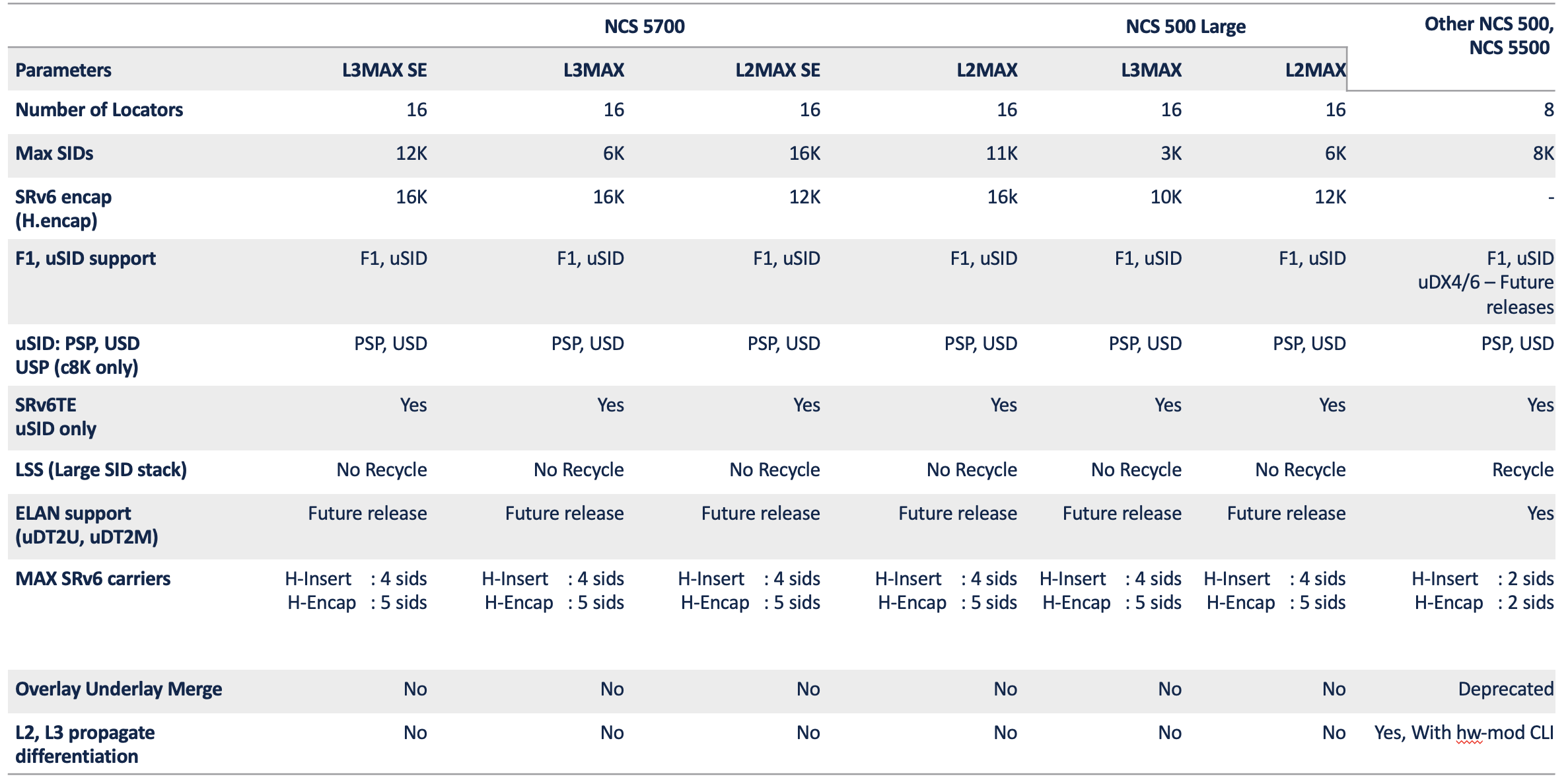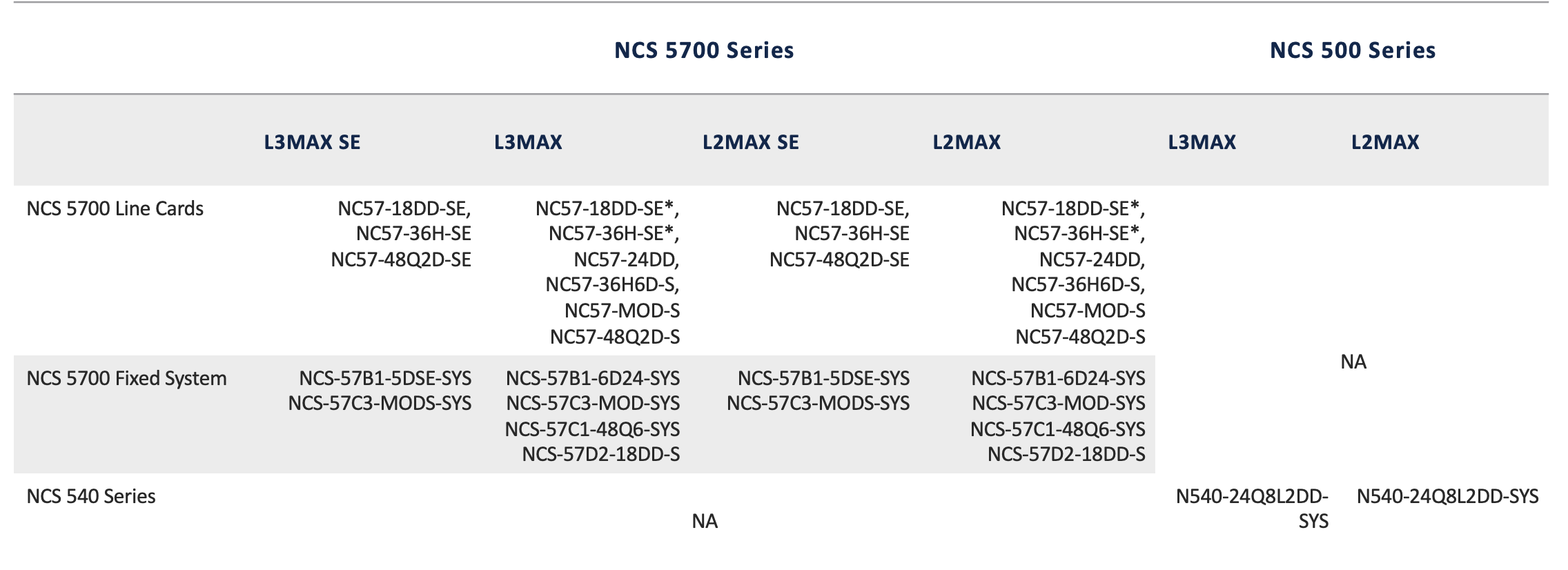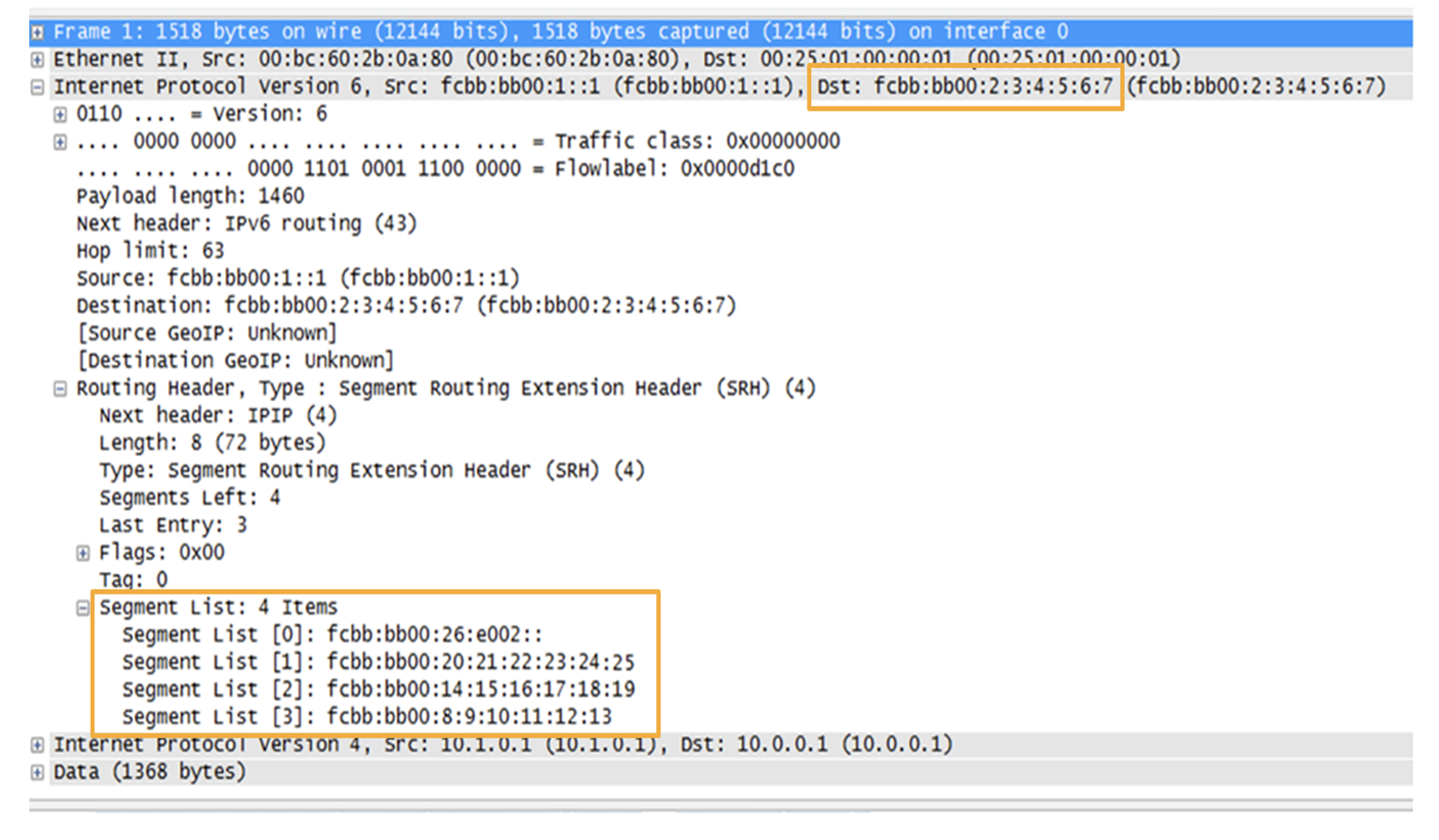SRv6 Transport on NCS5500/5700/500 : Capabilities & Resource Monitoring
| Deepak Balasubramanian, Technical Leader, Technical Marketing ([email protected]) |
| Paban Sarma, Technical Marketing Engineer ([email protected]) |
Overview
This is the 5th tutorial in SRv6 series on NCS5500/NCS500 platforms. In this article we will focus on covering the platform capabilties and resources usage when we provision SRv6 services on NCS5500/5700/500 product-family which is build with BCM DNX Jericho/Jericho+/Jericho2 NPUs.
Platform Capabilties
Let’s get started with a summary on capabilties of the platforms under discussion with respect to SRv6 features & scale.
Details are also captured in correspondance to different MDB profiles which are supported in NCS5700 platforms. For more understanding on MDB refer to NCS700-MDB-Info

Table #1 Platform Capabilities
Please note: Above scale numbers are subjected to change in the future XR releases along with more feature enhancements in the pipeline
MDB to PID mapping for reference

Table #2 Platform MDB mapping
SRv6 Manager CLI for details
We have an IOS-XR CLI to check the SRv6 functional and scale capabilities on any of the Cisco XR platforms. CLI : “show segment-routing srv6 manager”
Illustration below
“sh segment-routing srv6 manager”
Parameters:
SRv6 Enabled: Yes
SRv6 Operational Mode:
Micro-segment:
SID Base Block: fc05::/24 /*Configured base block*/
Encapsulation:
Source Address:
Configured: ::
Default: 100:1:1::1 /*Loopback IP*/
Hop-Limit: Propagate /*Configured Values*/
Traffic-class: Propagate /*Configured Values*/
Summary:
Number of Locators: 15 (15 operational) /*Current scale*/
Number of SIDs: 6749 (0 stale) /*Current scale*/
Max SID resources: 12256 /Scale Limit J2 L3MAX-SE/
Number of free SID resources: 4487
OOR:
Thresholds (resources): Green 613, Warning 368
Status: Resource Available /*Current OOR state*/
History: (0 cleared, 0 warnings, 0 full)
Block fc05::/32:
Number of free SID resources: 7607
Max SIDs: 7680
Thresholds: Green 384, Warning 231
Status: Resource Available
History: (0 cleared, 0 warnings, 0 full)
_/snipped/_
Block fc05:4::/32:
Number of free SID resources: 4946 /*Current Available resources*/
Max SIDs: 7680 /Max scale limit per block/
Thresholds: Green 384, Warning 231
Status: Resource Available
History: (0 cleared, 0 warnings, 0 full)
_/snipped/_
Platform Capabilities:
SRv6: Yes
TILFA: Yes
Microloop-Avoidance: Yes
Endpoint behaviors:
End.DX6 /*F1 per-CE v6*/
End.DX4 /*F1 per-CE v4*/
End.DT6 /*F1 per-VRF v6*/
End.DT4 /*F1 per-VRF v4*/
End.DX2 /*F1 P2P VPWS*/
End (PSP/USD)
End.X (PSP/USD)
uN (PSP/USD) /*node locator*/
uA (PSP/USD) /*Adjacency usid*/
uDX6 /*usid per-CE v6*/
uDX4 /*usid per-CE v4*/
uDT6 /*usid per-VRF v6*/
uDT4 /*usid per-VRF v4*/
uDX2 /*usid P2P VPWS*/
uB6 (Insert.Red) /*BSID for SRv6TE*/
Headend behaviors:
T
H.Insert.Red /*SID Insert - LFA,TE*/
H.Encaps.Red /*L3 encap*/
H.Encaps.L2.Red /*L2 encap*/
Security rules:
SEC-1
SEC-2
SEC-3
Counters:
CNT-3
Signaled parameters:
Max-SL : 11
Max-End-Pop-SRH : 5
Max-H-Insert : 4 sids / 4 Max carriers Inserted/
Max-H-Encap : 5 sids / 5 MAX carriers while encap/
Max-End-D : 8
Configurable parameters (under srv6):
Encapsulation:
Source Address: Yes
Hop-Limit : value=Yes, propagate=Yes
Traffic-class : value=Yes, propagate=Yes
Default parameters (under srv6):
Encapsulation:
Hop-Limit : value=0, propagate=No
Traffic-class : value=0, propagate=No
Max Locators: 16 /Max scale for locators/
Max SIDs: 12256 /Max scale for L3MAX-SE/
SID Holdtime: 3 mins /*Configurable value for SID clean=up*/
Highlights for critical params in above output
SRv6 MAX SIDs
Every platform with the combination of MDB profiles (NCS5700) will have maximum SID allocation limit. Numbers mentioned in Table#1 We can use the below CLI to check the max SIDs (local) supported on the router,
sh segment-routing srv6 manager | i Max SID r
Max SID resources: 12256
In SRv6, we can support multiple locators for various reasons like slicing/flex-algo. And we enforce max CAP per locator block which can be checked with,
sh segment-routing srv6 manager | i "Block|Max SIDs"
Block fc05::/32:
Max SIDs: 7680
Please note, Sum of the SIDs in different locator blocks should be <= Max SID resources supported
We will see in detail about the local SID allocation for different SID functionalities. Lets keep the focus restricted to uSID and not Format1
These are some of the important uSID functionalities we have today
- uN : Locator SID
- uA : Adjacency SID
- uDT4/6 : Per-VRF SID for GRT/VPN (ipv4/ipv6)
- uDX4/6 : Per-CE SID for GRT/VPN (ipv4/ipv6)
- uDX2 : L2VPN SID for EVPN VPWS
- uB6 : BSID for SRv6 Policy
- uDT2U: EVPN ELAN SID for known-unicast
- uDT2M : EVPN ELAN SID for BUM traffic
Calculaton goes like this,
MAX SIDs allocated = sum (uN:uLocal) + 2*uA
- 16 uN SIDs are reserved by default in hardware to avoid issues with locator configs during OOR conditions
- uLocal here is the local SID on the box which can fall into categories like (uA, uDT4/6, uDX4/6/2 .. etc )
- uA is counted twice, once as a part of uN:uLocal (uLocal = uA),and twice for local-only uA
Example:
sh segment-routing srv6 manager
Summary:
Number of Locators: 15 (15 operational) /*uN or Locators*/
Number of SIDs: 6749 (0 stale) /* SID usage*/
Max SID resources: 12256
Number of free SID resources: 4487 /* 12256 - 6749 != 4487 :) */
OOR:
Thresholds (resources): Green 613, Warning 368 /* Free resources > 5% of MAX SID for Green*/
Status: Resource Available /*To recover from OOR state, need to be in GREEN threshold*/
sh segment-routing srv6 sid | i uA | ut wc
510 4080 56100
RP/0/RP0/CPU0:J2-PE1#sh segment-routing srv6 sid | i "uDT|uDX|uB" | ut wc
6239/ 37482 686534
Number of SIDs: Equals to sum of uLocals (uA,uDT,uDX,uB) = 6749
Actual SID resource usage: 6749 + 2*510 (uA) = 7769
Number of free SID resources: Max SID (12256) - SID in use (7769) = 4487
OOR (Out Of Resource) monitoring for MAX SIDs
Illustration:
sh segment-routing srv6 manager
Summary:
Number of Locators: 15 (15 operational)
Number of SIDs: 6749 (0 stale)
Max SID resources: 12256
Number of free SID resources: 4487
OOR:
Thresholds (resources): Green 613, Warning 368 /*Global Free resources > 5% of MAX SID for Green*/
Status: Resource Available /*To recover from OOR state, need to be in GREEN threshold*/
Block fc05:3e::/32:
Number of free SID resources: 4946 /* Block level MAX free SIDs = 7680 - current allocation from the block*/
Max SIDs: 7680
Thresholds: Green 384, Warning 231 / > 5% green threshold for Block level max SID/
Status: Resource Available
Global level OOR Threshold set based on SID usage across all the locator blocks (system level)
- Green threshold if (global level free resources > 5% of MAX SID on system level)
- Warning if (global level free resources < 3% of MAX SID on system level)
Block level OOR Threshold set based on SID usage on a specific block
- Green threshold if (Block level free resources > 5% of MAX SID for locator block)
- Warning if (Block level free resources < 3% of MAX SID for locator block)
If we reach the state of OOR “Out of Resources” we will stop programming the SIDs till we go back to GREEN Threshold
SRv6 Encap resource usage
SRv6 uSIDs (remote) consumes encap resources (in EEDB-Egress Encap DataBase) like the MPLS labels. In NC57 (J2) systems we have encap bank carving in the form of cluster bank pairs which are dedicated to different network applications like SRv6, L3VPN, BGP LU ..etc
SRv6 encap usage can be monitered as srv6nh category which is similar to mplsnh for labels
RP/0/RP0/CPU0:J2-PE1#sh controllers npu resources encap location 0/4/CPU0
HW Resource Information
Name : encap
Asic Type : Jericho Two
OFA Table Information
(May not match HW usage)
ipnh : 1038
ip6nh : 2042
mplsnh : 79
srv6nh : 5185
SRv6NH scale depends on the remote SIDs which we use for the H/T.Encap (like encapsulating with DT4/6 or DX4/6/2 SIDs) and T.Insert (which we use for TILFA or SRv6TE scenarios) We also use the encap resources for SRv6-Policy which is not tied to the H.encap numbers in Table#1
SRv6 FEC resource usage
FEC table is present in the ingress pipleline of the NPU forwarding block. Basically a prefix/label/SID lookup can point to a FEC entry which will have information about the VOQ of the egress interface and also the encap pointers where the remote labels/SIDs are stored.
In NCS5700 we have 3 levels of FEC hierarchy vs 2 levels in NCS5500/540 systems Below is an ouput from NCS5700 system where we can see the services SID in H2 FEC and locator SIDs in H3 FEC.
show controllers npu resources fec location 0/1/CPU0
Name: hier_0
Estimated Max Entries : 52416
Total In-Use : 8 (0 %)
OOR State : Green
Bank Info : H1 FEC
Name: hier_1
Estimated Max Entries : 209664
Total In-Use : 45 (0 %)
OOR State : Green
Bank Info : H2 FEC >> Services SID
Name: hier_2
Estimated Max Entries : 78592
Total In-Use : 9 (0 %)
OOR State : Green
Bank Info : H3 FEC >> uN locator SID
SRv6 ECMP_FEC resource usage
We use ECMP_FEC for multipath/ECMP entries pointing to a list of FEC array. This database is also used by SRv6 when we have to deal with multipaths. In NC5700 ecmp_fec mapping follows similar application mapping hierarchy as that of FEC.
This can be monitored with,
show controllers npu resources ecmpfec location 0/RP0/CPU0
Current Hardware Usage
Name: ecmp_fec
Estimated Max Entries : 32768
Total In-Use : 6 (0 %)
OOR State : Green
Bank Info : ECMP
Name: hier_0
Estimated Max Entries : 30720
Total In-Use : 0
OOR State : Green
Bank Info : H1 ECMP
Name: hier_1
Estimated Max Entries : 30720
Total In-Use : 1
OOR State : Green
Bank Info : H2 ECMP >> Services SID
Name: hier_2
Estimated Max Entries : 32763
Total In-Use : 5
OOR State : Green
Bank Info : H3 ECMP
SRv6 Ultra USID scale with NCS5700
With the encap budget in NCS5700 we can do “Ultra-Scale packing for SRv6 uSIDs”
Max-H-Insert : 4 sids / 4 Max carriers Inserted/
Max-H-Encap : 5 sids / 5 MAX carriers while encap/
Using this encap budget we have succesfully validated 26 usids packing in a single pass. (24 Transport uSIDs + 2 Service USIDs)
 !
!

Showtechs required to troublesshoot SRv6 issues
show tech cef
show tech cef platform
show tech l2vpn
show tech l2vpn platform
show tech ofa
show tech segment-routing traffic-eng
show tech routing isis
show tech routing bgp
show tech ipv6 nd
Summary
This article has given an overview on the SRv6 capabilities with respect to the NCS platforms based on the differences in the forwarding asics and the MDB profiles. We also touched upon the important XR commands and outputs to check on the capabilities, scale of the platform with respect to SRv6 and also covered the resource usage for important on chip databases.
This concludes SRv6 series Part-5. Please stay tuned for more !
Leave a Comment